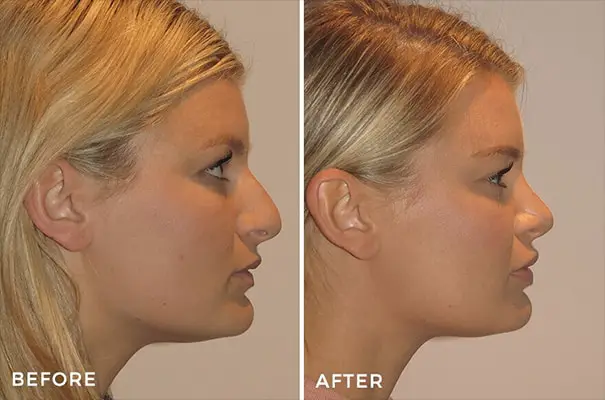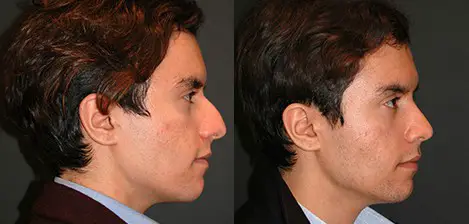
The rhinoplasty, popularly known as a “nose job,” is a procedure that helps change the shape, form, or function of the nose. It can also be used to correct both form and function. The goal of the nose job procedure is to create a more harmonious balance with the entirety of the face. However, it is an invasive and complex surgery that doesn’t come without risks.
The main risks involved with a nose job are infection, scarring, smell changes, anesthesia issues, and the possible need for revision surgery.
A related procedure, called the septoplasty, is performed to enhance breathing function from within the nose and to improve airflow through it. Another type of rhinoplasty called turbinate reduction surgery can be performed to correct breathing difficulties.
A nose job procedure may seem simple, but it is one of the most complex of all plastic surgery procedures because of the architecture of the nose, which consists of skin, cartilage, and bone. All three components must come together in three dimensions to allow for proper breathing and a pleasing aesthetic appearance. Any alterations of these three components can have unexpected effects with the other elements of the nose structure, leading to alterations in both appearance and functionality. After a nose job, the nose of the patient should appear quite natural and in harmony with the entire face.

For an overview of important nose aesthetics principles, check out this Looks Theory episode:
Surgery Risks
As with any surgical procedure, a nose job carries some level of risk for the patient. Even a basic mole removal procedure involves some level of risk. It is important to understand both the benefits and potential adverse events that can follow a nose job procedure.
Why Get a Nose Job?
The idea of facial harmony is a huge motivational force behind most cosmetic nose job procedures. This is the concept that each of your facial features should be proportionally balanced to each other. Many individuals seeking cosmetic nose surgery feel that their noses are out of balance with the rest of their face.
As a central feature of your face, altering the appearance of your nose can lead to improved self-esteem and confidence. So when you are deciding if a nose job is the right move for you, it is important to determine what you like and dislike about your nose in relation to your other features.
A few examples of how a nose job can improve the appearance of your nose in correcting:
- A large nasal bridge hump
- A crooked nose bridge
- An overly large or bulbous tip, or a tip that turns up at a steep angle
- A nasal tip crease
- A nose that is perceived as too small or overly prominent
In addition to cosmetic issues with the nose, a nose job can correct functional problems like difficulty breathing or glasses that are never comfortable on the face due to the shape of the nose.

Open and Closed Rhinoplasty
Your plastic surgeon will determine what technique is best for what you are trying to achieve with your nose job. Both open and closed rhinoplasty procedures provide sufficient space for the surgeon to perform your nose job. The closed technique consists of forming up to four incisions within your nostrils. Your surgeon will also form an incision across the outside of the nose and peel the skin on the nose tip upwards to allow access. He or she will then pull away cartilage and bone. At this point, they will perform the surgery and reposition the skin, and any incisions will be sewn up.
The benefit of having a closed rhinoplasty is that no external incision is needed, resulting in quicker recovery times. The main benefit of the open type of rhinoplasty is that more access is gained, which may be needed for a revision rhinoplasty procedure. The open technique has the disadvantage of a resulting incision that will be noticeable for a few months and visible scar tissue and extensive swelling of the nasal tip.
Limitations of Rhinoplasty Procedures: What Can Go Wrong
From the perspective of the patient undergoing a nose job, the procedure may not achieve the results that they envisioned in their minds before undergoing their surgery. This is why it is vitally important that the patient communicate fully with their plastic surgeon during their initial rhinoplasty consultation. The patient needs to have realistic expectations regarding their results.
There is no such thing as a perfect nose, and a plastic surgeon – no matter how skilled – cannot turn an average person into a movie star overnight.

Risks of the Nose Job Procedure
Undergoing any type of plastic surgery is an extremely personal decision. You will need to decide if the benefits outweigh its risks. At your consultation, your plastic surgeon will go over any risks involved with your nose job. You may need to sign consent forms indicating that you completely understand the rhinoplasty procedure and any risks involved.
Anesthesia Risks
There is always some risk of going under anesthesia during any surgery, but it is extremely low, particularly in modern times. Only about one in every 200,000 patients die because of anesthesia, due to recent advancements in both medication and technology.

Anesthesiologists use special devices to ensure that you receive sufficient oxygen during your rhinoplasty procedure. A device called a pulse oximeter ensures that your breathing tube goes into your windpipe and not the esophagus.
Anesthesiologists are trained to look out for malignant hyperthermia – a very rare reaction to anesthesia resulting in high fever, complications, and possibly death.
Some patients fear waking up during their surgical procedure. However, during general anesthesia, the patient’s blood pressure and heart rate are carefully monitored. Both would noticeably rise before the patient regained awareness.
Risk of Infection
Any time an injection or incision is needed, there is a risk of developing an infection. However, this risk is extremely low for a nose job procedure. With any surgery, the chances of developing a surgical site infection (SSI) is no greater than three percent.
Poor scarring can cause problems in both open and closed rhinoplasties. In some patients, scarring within the nose can add additional bulk, leading to irregular nasal contours. Or unsightly scars on the surface of the nose can harm the patient’s overall appearance and make it more obvious that they had a nose job procedure performed.
The best cosmetic surgeons realize that patients are concerned about unsightly scars and take measures to ensure that any resulting scars are very faint, small, and well-healed. The important point is that the surgeon takes their time and pays attention to detail.

Rhinoplasty Revision
Nose jobs are a technically difficult type of surgery. Revision rhinoplasty is simply a rhinoplasty that is performed to correct a previous surgery. The healing process following rhinoplasty can affect the final outcome. This can lead to results that the patient is unhappy with. So a revision rhinoplasty helps to correct any problems with the original nose job.
The patient may also request a revision rhinoplasty when they are unhappy with the aesthetic results of their procedure, even if the surgeon viewed the surgery as a success. For example, the patient and the surgeon may have been on a different page regarding what the patient hope to achieve cosmetically with their surgery.
Some additional risks of a nose job procedure are:
- Poor wound healing
- Numbness or pain
- Difficulty with breathing
- Skin swelling and discoloration
- Nasal septal perforation ( hole in the nasal septum)
Bottom Line
The nose job is a popular type of plastic surgery that can significantly enhance your facial appearance. You need to keep in mind that, as a type of surgery, a small level of risk is involved. You can reduce this risk even further by informing your plastic surgeon of your current and past medical history, as well as carefully following both their pre and postoperative instructions.


